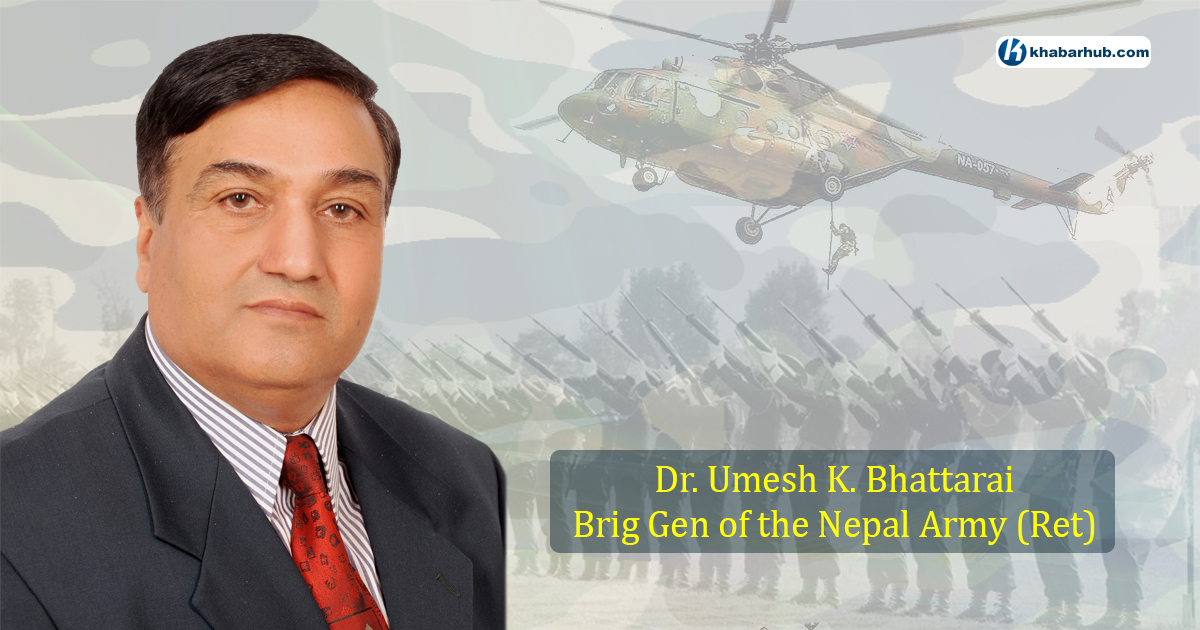0%
All the colors associated with the Nepal Army were primarily established by King Prithvi Narayan Shah and subsequent Shah Rulers through Tantra Vidyas.

Majority of the Nepalis worship Lord Shiva. The Kirats worship Shiva as their Aradhya Dev (Godfather or Ista Devta). Lord Shiva is considered a base of the Hindu civilization and protector of the Sanatan Dharma as per the eastern philosophy.
A common religion or faith is essential for better cohesion and unity. Given its history, Nepal has remained an example of such religious harmony. Lord Shiva is the source of energy and power to counter prevailing societal evils all together.
Basically, Hindu religion, including other Omkar samuha (groups that revere ‘Om’) who worship Lord Shiva as god believe that Shivatwa (way of Lord Shiva) is the source of finding own self as Bramha (or the realization that the self and the universe are in fact the same). Shivatwa is the source of salvation to inner peace that leads to Mokshya (liberation in the real sense). Once we achieve Shivatwa, we need not clamor for happiness anymore.
Mahashivaratri is also celebrated as Nepal Army Day since 1991. Earlier, there was no such day observed as army day in particular, but Ghode Jatra (Horse race and other related exhibition) were observed in lieu of army day where army parades were displayed annually at Tundikhel. In Mahashivaratri, Nepal Army used to organize Badhai parade only to mark as a religious and cultural ceremony.
With Lord Shiva’s inspiration and blessings, Nepal Army was formed by the Gorkha King Prithvi Narayan Shah in the year 1743-1744 to unify tiny principalities into a single country, Nepal. Prithvi Narayan Shah was the true follower of Gorakh Nath, who had blessed him as a successful founder of modern Nepal. Gorakh Nath is from Nath Sampradaya (Nath community) and Nath represents none other than Lord Shiva. That is why we have Pashupatinath in Kathmandu, a highly revered Hindu temple.
In fact, Prithvi Narayan Shah was suspicious of the invasion of Nepal by the British ruling over India. However, feuding principalities within Nepal’s territory were not really serious about the British move. But the visionary Gorkha king was determined to unify Nepal to counter the lurking British invasion. This unification campaign was initiated in 1740 when the British were consolidating power in India. After capturing the Kathmandu Valley in 1743-44, the Gorkhali armed forces were known as Nepali Army.
Goddess Mahakali is worshipped for destroying devils. Properties of Lord Shiva and Goddess Mahakali commensurate with that of Nepal Army since it has been working for the welfare of Nepalese society and for maintaining peace and order in the Nepalese society.
Mahashivaratri is also celebrated as Nepal Army Day since 1991. Earlier, there was no such day observed as army day in particular, but Ghode Jatra (Horse race and other related exhibition) were observed in lieu of army day where army parades were displayed annually at Tundikhel. In Mahashivaratri, Nepal Army used to organize Badhai parade only to mark as a religious and cultural ceremony.
In fact, Mahashivaratri has a close connection with the army as it is the day Lord Shiva drank poison as a symbol of negativity to protect the universe. This is the night when Lord Shiva performs the heavenly dance of creation, preservation, and destruction. This festival is also marked as the legendary marriage of Shiva and Shakti (Parvati) who is considered as Durga as well as Mahakali. Goddess Mahakali is worshipped for destroying devils. Properties of Lord Shiva and Goddess Mahakali commensurate with that of Nepal Army since it has been working for the welfare of Nepalese society and for maintaining peace and order in the Nepalese society.
All the colors associated with the Nepal Army were primarily established by King Prithvi Narayan Shah and subsequent Shah Rulers through Tantra Vidyas. These colors have a real connection with Shivaism. That is why the colors of Nepal Army are not only considered as the symbols of unity for the specific units within the army but are considered as Nishan Deuta or iconic deities (representing Lord Shiva and Goddess Parvati/Mahakali). With this logic, Nepal Army has been celebrating the Mahashivaratri as its auspicious ‘Army Day’ since 1991 onwards.
Dr. Bhattarai is a retired Brig Gen of the Nepal Army
(Views expressed in this article are the author’s own and do not necessarily reflect Khabarhub’s editorial stance).